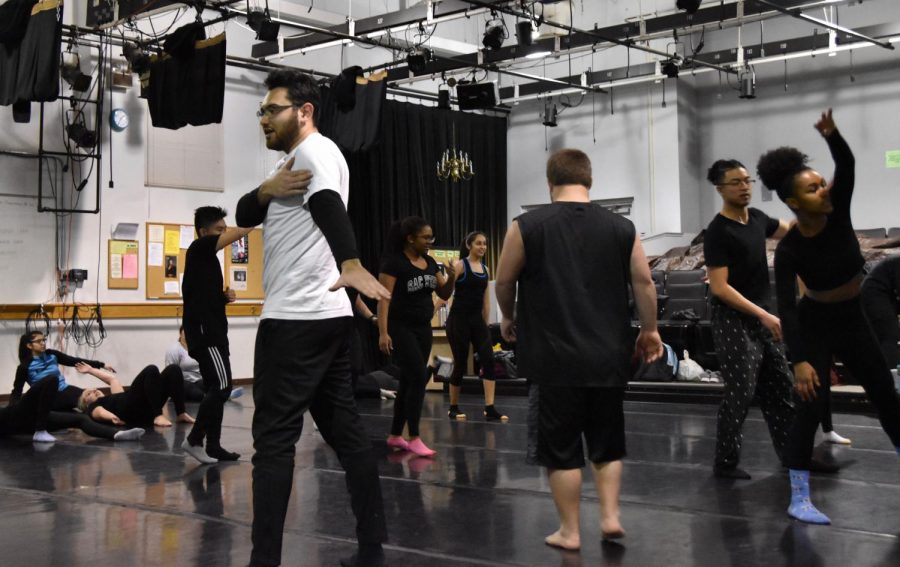Infrastructure problems, curriculum pose challenges for dance program accreditation
Vincent Moleski – The State Hornet
Dance students warm up before class in Solano 1010 on Thursday, Feb. 22, 2018. The dance program at Sac State is pursuing accreditation by the National Association of Schools of Dance, but faces architectural issues in Solano Hall and elsewhere.
The Sacramento State Department of Theatre and Dance is seeking to gain accreditation for its dance program from the National Association of Schools of Dance, but it faces challenges with its infrastructure and curriculum.
Lorelei Bayne, the interim chair of the Theatre and Dance Department, said that she hopes to have the dance program accredited within five years, but Solano and Yosemite halls, which the program uses for rehearsal and performance space, would have to be renovated first.
Bayne said the lack of student dressing rooms and bathrooms on the first floor of Solano Hall currently bars the program from accreditation, and may not be in compliance with the Americans with Disabilities Act.
Additionally, Bayne said the sprung floors in the dance classrooms in Yosemite Hall will need to be replaced or fixed to ensure safety for dancers.
Philip Flickinger, a dance professor in the department, said that the current state of Solano Hall has caused issues for students. He estimated the total cost for necessary renovations will be over $25 million.
“About two, three years ago, we were getting ready for a show (in Solano), and all of a sudden two of the dancers come in and they’re like, ‘Hey Flick, just so you know, two dancers are stuck in the elevator between floors,’ ” Flickinger said. “And I was like, ‘Awesome. Let’s get them out of there.’ ”
Bayne said that for performances in Solano, students sometimes have to change costumes in classrooms borrowed from the kinesiology department.
Alli Franco, a 27-year-old dance major, said that she has experienced her own problems in Solano Hall during performances.
Franco said the changing situation during a senior concert in spring 2017 was a hassle for her and other students.
“Injuries could have possibly happened, so we just had to be very aware when dancers would have to run around entering stage left or right,” Franco said. “We were changing and running between people who were changing for the next piece, which could be very problematic, especially if the piece required a lot of entrances and exits.”
Flickinger said that although there is one dressing room in Solano, it is for faculty, and students are not able to access it during the day.
“Renovations to any of our buildings — as you probably are well aware of with the new science building — those are multimillion dollar projects, and as much as the university system seems like it has money lying around, it really doesn’t,” Flickinger said.
The dance program received a consultation in 2014 from the association that outlined the improvements required for accreditation, but Bayne said the program would likely need to have another, updated consultation for the new dean of the college, Sheree Meyer, who took over last year.
Flickinger said an updated consultation won’t happen this year because the dance department is still working on necessary curriculum changes.
He said dance students can expect to see a reordering of the dance catalog in the next year, including name and number changes for some courses.
Other requirements that the department is working on addressing, according to Flickinger, include adding more dance faculty, increasing the length of technique classes and adding more dance courses.
He said that one of the problems with adding certain types of courses the program is considering, such as dance classes with live musical accompaniment, is funding.
“For the contemporary student, is it reasonable to say that we’re going to have live accompaniment and ask the students to then pay for it?” Flickinger said. “We take cost into consideration, so we’re trying to figure out ways to get the musicians into our classrooms without it falling directly on the students.”
Bayne said that one requirement she was confident could be met by fall is the addition of another full-time dance faculty member, making a total of four.
According to the association, there are only six accredited dance programs in California. Even so, Flickinger said that as Sac State’s program continues to grow, accreditation is the next step — though he said the timeline depends largely on economics.
“With the ever-looming presence of financial insecurity that I think we’re starting to feel again, it’s not a promise that … new buildings are going to go up, or even remodeling of old buildings,” said Flickinger, though he added that the University has been accommodating and supportive of the dance department and that President Robert Nelsen has never missed a theater or dance performance.
Bayne said accreditation would ensure that the curriculum stays up to date, foster the reputation of the dance program at Sac State and help to bring outside talent to the campus.
“I think that President Nelsen — and our dean of the college and the provost — knows how important it is for us,” Bayne said. “The goal is to better serve students.
“I’m really optimistic that these issues … will be addressed so that we can move forward with the accreditation.”
Even though she plans on graduating before the dance program’s five year goal, Franco said that she would like to see the benefits of accreditation for new students.
“There are a lot of professional jobs you can go into through the arts and I think it should be taken seriously, which is why (the dance program) should be accredited,” Franco said.
Your donation will support the student journalists of Sacramento State University. Your contribution will allow us to purchase equipment and cover our annual website hosting costs.


























































































































